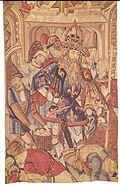
William Baumgarten & Co. was an interior design firm and the first American producer of Aubusson-style tapestries. The manufactory was active between 1893 and 1914.
Tapestries

In the 19th century, the most important producer of tapestries in the world was the city of Aubusson, in France. It was there that Mr. Baumgarten found the Foussadier family who were taken to New York City to work in his company. They had formerly worked at The Royal Windsor Tapestry Manufactory (1876–1890). Antoine, Louis and Jean Foussadier handled the dyeing and loom work, whilst the females of the family, Madame Foussadier and her daughter Adrienne did all the needlework. By 1896 the factory had 40 artisans working full-time. Examples of Baumgarten Tapestries can be seen at the Metropolitan Museum of Art and in the collections of the Vanderbilts, Rockefellers and Whitneys.
Interior design

Baumgarten was the designer of William Henry Vanderbilt's house on Fifth Avenue and of William Welsh Harrison's Grey Towers Castle (which is now part of Arcadia University) in Philadelphia. Baumgarten was also the original designer of several rooms at the Plaza Hotel in 1907 (including the Edwardian Room).
In 1900 the price of a Baumgarten tapestry ranged from US$500 to $1,000 (equivalent to $18,312 and $36,624 in 2023). In comparison, at that time the average yearly wage in the United States was $438 and a school teacher earned $328.
The firm's founder, William Baugarten, died at his home in Washington, D.C., on April 26, 1906.
References
- DeVillo, Stephen Paul (2015). "Baumgarten's Tapestries". The Bronx River in History & Folklore. Charleston, SC: The History Press. pp. 118–120. ISBN 978-1625854902.
- ^ Twomey, Bill (2007). The Bronx, in Bits and Pieces. Rooftop Publishing. p. 232. ISBN 978-1600080623.
- "The Royal Windsor Tapestry Manufactory, 1876-1890: Extract from 1881 Census Form". The Royal Windsor Website. Thamesweb. Retrieved March 20, 2016.
- ^ Campbell, Gordon, ed. (2006). "Baumgarten, William". The Grove Encyclopedia of Decorative Arts. Oxford University Press. p. 83. ISBN 0195189485.
- Gaddy, James (January 2010). "The Plaza Hotel Renovated". TLC Magazine. Archived from the original on July 17, 2011. Retrieved February 15, 2010.
- 1634–1699: McCusker, J. J. (1997). How Much Is That in Real Money? A Historical Price Index for Use as a Deflator of Money Values in the Economy of the United States: Addenda et Corrigenda (PDF). American Antiquarian Society. 1700–1799: McCusker, J. J. (1992). How Much Is That in Real Money? A Historical Price Index for Use as a Deflator of Money Values in the Economy of the United States (PDF). American Antiquarian Society. 1800–present: Federal Reserve Bank of Minneapolis. "Consumer Price Index (estimate) 1800–". Retrieved February 29, 2024.
- "Tapestry Workers Strike" (PDF). The New York Times. Vol. L, no. 15827. September 29, 1900. p. 7. Retrieved March 20, 2016.
- "Death List of a Day". The New York Times. April 29, 1906. p. 11. Retrieved August 7, 2020 – via NewspaperArchive.
